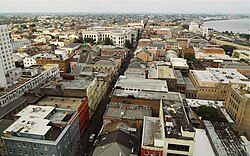
Back فرنچ کوارتر AZB French Quarter (New Orleans) German Γαλλική συνοικία Greek Franca Kvartalo Esperanto Barrio Francés de Nueva Orleans Spanish Frantziar Auzoa (New Orleans) Basque فرنچ کوارتر Persian Ranskalaiskorttelit Finnish Vieux Carré français French הרובע הצרפתי HE
French Quarter
Vieux Carré (French) | |
|---|---|
 The French Quarter, looking north with Mississippi River to the right | |
 | |
| Coordinates: 29°57′31″N 90°03′54″W / 29.95861°N 90.06500°W | |
| Country | United States |
| State | Louisiana |
| City | New Orleans |
| Planning District | District 1, French Quarter/CBD |
| Area | |
• Total | 0.66 sq mi (1.7 km2) |
| • Land | 0.49 sq mi (1.3 km2) |
| • Water | 0.17 sq mi (0.4 km2) |
| Elevation | 3 ft (0.9 m) |
| Population (2010) | |
• Total | 3,888 |
| • Density | 5,900/sq mi (2,300/km2) |
| Time zone | UTC-6 (CST) |
| • Summer (DST) | UTC-5 (CDT) |
| ZIP Codes | 70116 – 70130 |
| Area code | 504 |
Vieux Carre Historic District | |
| Built | 1734 |
| NRHP reference No. | 66000377 |
| Significant dates | |
| Added to NRHP | October 15, 1966[2] |
| Designated NHLD | December 21, 1965[3] |
The French Quarter, also known as the Vieux Carré (UK: /ˌvjɜː kəˈreɪ/; US: /vjə kəˈreɪ/;[4] French: [vjø kaʁe]), is the oldest neighborhood in the city of New Orleans. After New Orleans (French: Nouvelle-Orléans) was founded in 1718 by Jean-Baptiste Le Moyne de Bienville, the city developed around the Vieux Carré ("Old Square" in English), a central square. The district is more commonly called the French Quarter today, or simply "The Quarter", related to changes in the city with American immigration after the 1803 Louisiana Purchase.[5] Most of the extant historic buildings were constructed either in the late 18th century, during the city's period of Spanish rule, or were built during the first half of the 19th century, after U.S. purchase and statehood.
The district as a whole has been designated as a National Historic Landmark, with numerous contributing buildings that are separately deemed significant. It is a prime tourist destination in the city, as well as attracting local residents.
The French Quarter suffered relatively light damage from floodwater as compared to other areas of the city and the greater region, due to its distance from areas where the levee was breached during Hurricane Katrina in 2005 as well as the strength and height of the nearest Mississippi River Levees in contrast to other levees along the canals and lakefront.[6]
- ^ "City Charter". City of New Orleans. Archived from the original on January 4, 2010.
- ^ "National Register Information System". National Register of Historic Places. National Park Service. January 23, 2007.
- ^ "Vieux Carre Historic District" (National Historic Landmark summary listing). National Park Service. Archived from the original on September 25, 2008. Retrieved January 31, 2008.
- ^ "the-vieux-carre - Definition, pictures, pronunciation and usage notes | Oxford Advanced Learner's Dictionary at OxfordLearnersDictionaries.com". www.oxfordlearnersdictionaries.com. Archived from the original on June 4, 2018. Retrieved January 15, 2025.
- ^ "New Orleans French Quarter History, Architecture and Pictures". Archived from the original on March 25, 2013. Retrieved October 28, 2006.
- ^ "Archived copy". Archived from the original on January 30, 2015. Retrieved February 15, 2015.
{{cite web}}: CS1 maint: archived copy as title (link)

